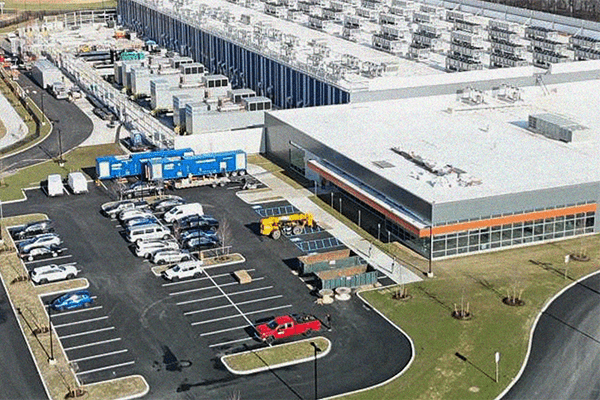|
RCBJ-Audible (Listen For Free)
|
Data Centers Opening In Orangetown Use Massive Amounts Of Electric Power; Taxing The Grid To Run And Keep Cool
A ribbon-cutting in May celebrated the opening of DataBank’s newest data center at 2000 Corporate Drive in Orangeburg. Company executives joined County Executive Ed Day and Orangetown Supervisor Teresa Kenny for the formal opening of the first phase of two planned data centers at that location.
Along with new property taxes, and a handful of about a dozen promised jobs, DataBank’s project included the demolition of the old Verizon facility and construction of 110,000 square-foot state-of-the-art data center that will run on a 100 percent renewable energy source. The site’s substation enables Databank to connect directly to the power grid; it also has plans to build a second substation for future growth.
According to Rockland County, the project is estimated to generate more than $41 million in state and local economic benefits through a combination of property, income, and sales tax revenues over the next decade.
However, the increased demand from data centers can lead to higher electricity bills for average consumers if the full cost of infrastructure upgrades and energy supply isn’t fairly allocated. New York State is considering legislation to protect residential customers from potential bill increases by providing discounts to communities hosting data centers.
The demand for new data centers continues unabated, driven largely by Artificial Intelligence (AI) and the ongoing demand for data processing and storage. The hottest states for data centers include Virginia, California and Texas, Illinois, Georgia and Ohio, but New York is not far behind, and Rockland County hosts a number of large data centers (over 100,000 square feet) in and around Orangetown.
The Rockland County Industrial Development Agency (IDA) has been instrumental in attracting data centers to Orangetown with generous sales tax exemptions on the costs of construction and equipment. The building of these facilities also brings hundreds of short-term construction jobs for these enormous projects.
A more accurate way to measure data centers rather than by square feet though is by looking at capacity in megawatts. A megawatt (MW) is a unit of power equal to one million watts or 1,000 kilowatts. One MW can generally power between 800 and 1,000 homes in New York.
New data centers, like the one opened recently by DataBank in Orangeburg has a capacity 20 MW of critical power, or enough wattage to power between 16,000 and 20,000 homes. Its expansion plans project a second data center on site that would boost its power usage to 45 MW, enough to power up to 45,000 homes.
If you include apartments, Rockland County has about 110,000 housing units, about 60,000 of them are single-family detached homes.
Other data centers like the 130,000 square-foot Sentinel One data center at 155 Corporate Drive in Orangeburg has capacity at 10 MW, serving a single financial tenant. Its power usage equals about 10,000 homes. The 1547 Critical Systems data center at 1 Ramland Road in Orangeburg is 232,000 square feet with 24 MW of critical power capacity, equivalent to the power used by 24,000 homes.
Taken together, these few data centers use more power than the combined usage of every single-family home in the county. In addition to processor power, the data centers also use large amounts of electric power to cool their facilities. Some use massive amounts of water to cool their processors, though more modern facilities use closed-loop systems that cool and reuse water. Evaporative cooling systems (not in a closed loop) in a mid-sized data center can use up to 300,000 gallons of water a day.
Around New York, many data center are situated near abundant water sources.
The risk of overheating is so significant that data centers also build out UPS (Uninterruptible Power Supply) batteries that are crucial for maintaining power to critical systems during outages, ensuring continuous operation of servers and other essential equipment. These massive batteries act as a backup power source, bridging the gap between a power outage and the activation of generators, generally diesel generators which provide power to the centers until grid service is restored. Data centers, by design, are prepared for power failures.
According to the NYSIO (a not-for-profit corporation that manages the state’s bulk electricity grid and wholesale electricity markets), New York is poised to meet its power demands through 2034, based on a series of assumptions about off-shore wind, CHPE, the availability of natural gas, pipelines, renewable energy sources, crypto-currency mining, and proposed future chip manufacturing needs.
Some jurisdictions or utility companies have imposed holds or moratoriums on power supply to data centers, as they cannot guarantee or meet the data center power demands. This has prompted data center providers to look for different cities or regions, as well as alternative sources of power. These factors are influenced by the lack of power, the inability to distribute over high-power lines, or the demand for alternative power sources.
In New York, a significant portion of the costs for grid modernization and upgrades is borne by utility customers through their electric bills, including surcharges to recover investments made by utilities for projects to strengthen and modernize the grid. Federal and state funding programs, administered by organizations like NYSERDA and the DOE, also play a vital role in supporting these initiatives and sharing the financial burden.
New York State’s proposed legislation recognizes that the expansion and operation of data centers across the state impairs New York state’s ability to achieve the renewable energy and emissions reduction benchmarks required by the climate leadership and community protection act due to their significant use of energy and water and significant emissions of green-house gases generated through the power needs of their operation.
If data centers are in Rockland’s future (or New York’s future), planners need to consider how much electric power these facilities will require and where it will source its power. Also, approvals for new data centers should include a requirement for closed-loop liquid cooling system that do not burden local water utilities. Rockland’s proximity to New York City make it an attractive and cost-effective location for new data centers – how they operate and where they are located will impact electric, gas, and water costs for local residents for years to come.
Image: DataBank.com















